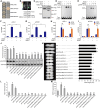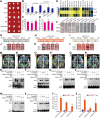Strigolactone-induced degradation of SMXL7 and SMXL8 contributes to gibberellin- and auxin-mediated fiber cell elongation in cotton
- PMID: 39046066
- PMCID: PMC11371155
- DOI: 10.1093/plcell/koae212
Strigolactone-induced degradation of SMXL7 and SMXL8 contributes to gibberellin- and auxin-mediated fiber cell elongation in cotton
Abstract
Cotton (Gossypium) fiber length, a key trait determining fiber yield and quality, is highly regulated by a class of recently identified phytohormones, strigolactones (SLs). However, the underlying molecular mechanisms of SL signaling involved in fiber cell development are largely unknown. Here, we show that the SL signaling repressors MORE AXILLARY GROWTH2-LIKE7 (GhSMXL7) and GhSMXL8 negatively regulate cotton fiber elongation. Specifically, GhSMXL7 and GhSMXL8 inhibit the polyubiquitination and degradation of the gibberellin (GA)-triggered DELLA protein (GhSLR1). Biochemical analysis revealed that GhSMXL7 and GhSMXL8 physically interact with GhSLR1, which interferes with the association of GhSLR1 with the E3 ligase GA INSENSITIVE2 (GhGID2), leading to the repression of GA signal transduction. GhSMXL7 also interacts with the transcription factor GhHOX3, preventing its binding to the promoters of essential fiber elongation regulatory genes. Moreover, both GhSMXL7 and GhSMXL8 directly bind to the promoter regions of the AUXIN RESPONSE FACTOR (ARF) genes GhARF18-10A, GhARF18-10D, and GhARF19-7D to suppress their expression. Cotton plants in which GhARF18-10A, GhARF18-10D, and GhARF19-7D transcript levels had been reduced by virus-induced gene silencing (VIGS) displayed reduced fiber length compared with control plants. Collectively, our findings reveal a mechanism illustrating how SL integrates GA and auxin signaling to coordinately regulate plant cell elongation at the single-cell level.
© The Author(s) 2024. Published by Oxford University Press on behalf of American Society of Plant Biologists. All rights reserved. For commercial re-use, please contact reprints@oup.com for reprints and translation rights for reprints. All other permissions can be obtained through our RightsLink service via the Permissions link on the article page on our site—for further information please contact journals.permissions@oup.com.
Conflict of interest statement
Conflict of interest statement. The authors declare no competing interests.
Figures







Similar articles
-
The SMXL8-AGL9 module mediates crosstalk between strigolactone and gibberellin to regulate strigolactone-induced anthocyanin biosynthesis in apple.Plant Cell. 2024 Oct 3;36(10):4404-4425. doi: 10.1093/plcell/koae191. Plant Cell. 2024. PMID: 38917246 Free PMC article.
-
Verticillium dahliae effector Vd06254 disrupts cotton defence response by interfering with GhMYC3-GhCCD8-mediated hormonal crosstalk between jasmonic acid and strigolactones.Plant Biotechnol J. 2025 Jul;23(7):2755-2768. doi: 10.1111/pbi.70098. Epub 2025 Apr 22. Plant Biotechnol J. 2025. PMID: 40263919 Free PMC article.
-
Deciphering the dynamic expression network of fiber elongation and the functional role of the GhTUB5 gene for fiber length in cotton based on an introgression population of upland cotton.J Adv Res. 2025 Jul;73:1-14. doi: 10.1016/j.jare.2024.08.004. Epub 2024 Aug 4. J Adv Res. 2025. PMID: 39106927 Free PMC article.
-
Transcriptional regulation of development by SMAX1-LIKE proteins - targets of strigolactone and karrikin/KAI2 ligand signaling.J Exp Bot. 2025 May 10;76(7):1888-1906. doi: 10.1093/jxb/eraf027. J Exp Bot. 2025. PMID: 39869020 Review.
-
Highlights in gibberellin research: A tale of the dwarf and the slender.Plant Physiol. 2024 Apr 30;195(1):111-134. doi: 10.1093/plphys/kiae044. Plant Physiol. 2024. PMID: 38290048 Free PMC article. Review.
Cited by
-
Mining and identification of factors influencing multi-branch plasticity in ornamental kale.Planta. 2025 May 10;261(6):134. doi: 10.1007/s00425-025-04708-y. Planta. 2025. PMID: 40348855
-
A GDSL esterase/lipase gene GbGELP identified from a fiber micronaire QTL qMIC-A11 modulates cell elongation and fiber development.Theor Appl Genet. 2025 May 25;138(6):126. doi: 10.1007/s00122-025-04915-x. Theor Appl Genet. 2025. PMID: 40413700
References
MeSH terms
Substances
Grants and funding
LinkOut - more resources
Full Text Sources

